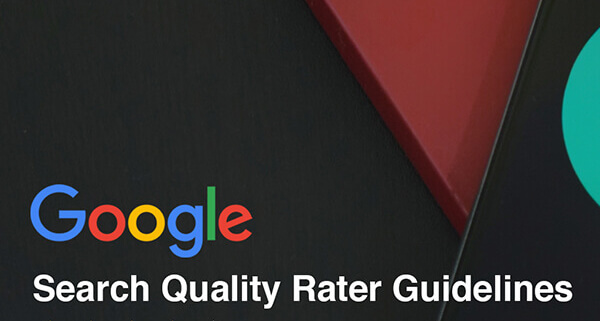What Webmasters Can Learn From Google’s Quality Rater Guidelines (QRG)

It’s no secret that Google uses an algorithm to rank websites. As its bots spider the internet, Google collects data on websites for use in its ranking algorithm. Google, however, often adjusts its ranking algorithm based on input from contracted workers. Known as quality raters, they evaluate the quality of websites using Google’s Quality Rater Guidelines (QRG).
According to Search Engine Land, there are over 10,000 quality raters worldwide who work for Google. Google assigns them search queries, which they perform while evaluating the quality of the top-ranked websites.
All quality raters judge websites using the guidelines set forth in Google’s QRG. If you’re a webmaster, you should take a close look at Google’s QRG. In this comprehensive 175-page document, Google reveals the factors that distinguish high-quality websites from low-quality websites. By understanding these factors, you can optimize your website more effectively for Google’s search results.
Content Should Satisfy Search Intent
Google’s QRG state that the content on a page should satisfy the intent of search users. Intent is defined by the search query a user performs. When a user performs a search query, he or she expresses some form of intent. Based on Google’s QRG, pages are considered high quality if their content satisfies the intent of the search queries for which they rank.
A user who searches for “gas vs electric furnaces,” for instance, is probably looking for information that compares these two types of central heating systems. A user who searches for “buy furnace,” on the other hand, is probably looking to purchase a furnace. Regardless, pages should have content that satisfies search intent.

Transparency Is Key
Google emphasizes transparency in its QRG. Quality raters are instructed to gauge the transparency of websites to determine their level of quality. When evaluating a website, they’ll look for things like contact information, a customer support desk and an “about us” page.
Not all websites will benefit from a customer support desk, but most of them will benefit from contact information and an “about us” page. Contact information and an “about us” page creates transparency. It shows visitors and Google that a website isn’t afraid to reveal its true identity. As a result, quality raters look for these transparency elements when evaluating websites.
YMYL Pages Are Heavily Scrutinized
Your money, your life (YMYL) pages are scrutinized more heavily than other pages. Pages are typically considered YMYL if they contain information or content that can affect a user’s health, money, happiness or safety. In its QRG, Google holds these YMYL pages to a higher standard because of their potential impact on users.
Examples of YMYL pages include:
- Checkout pages
- Bill pay portals
- Political pages
- Business news pages
- Medical or health information pages
- Academic information pages
- Legal information pages
- Safety information pages
- Financial information pages
- Credit or debt information pages

Mobile Optimization Is No Longer Optional
For a page to be considered high quality, it must be optimized for mobile devices. Google’s QRG, in fact, requires quality raters to give mobile-unfriendly pages the lowest possible rating. A page may load and function on desktop computers, but if it’s unusable on mobile devices, it will receive the lowest rating.
Quality raters are even instructed to use a mobile device when performing search queries and evaluating the quality of websites. They can’t use a desktop computer. The latest iteration of Google’s QRG specifically requires quality raters to use a mobile device.
The Quality of Third-Party Ads Matters
Millions of websites are monetized with third-party ads. Webmasters can partner with a third-party ad network, which allows them to display ads from various advertisers on their websites. According to Google’s QRG, the quality of these ads can influence the quality of the websites on which they are displayed.
Ads are a form of content, and like all content, they can increase or decrease the overall quality of a website. Google’s QRG explains that while webmasters may not have control over third-party ads, they are still responsible for the types of ads displayed on their websites. If a website displays misleading, deceptive, irrelevant or otherwise low-quality third-party ads, it will receive a low rating.
Quality raters will see third-party ads when evaluating websites. In addition to using a mobile device, Google instructs them not to use an ad blocker. Quality raters will specifically look at a website’s third-party ads when rating it.

Content Can Be Main or Supplementary
Google’s QRG classifies non-sponsored content as either main or supplementary. Main content (MC) is any content that plays a direct role in helping a page achieve its purpose. It includes articles, blog posts, guides, infographics, images and videos.
Supplementary content (SC), conversely, is any content that affects user experience but doesn’t help a page achieve its purpose. SC may include social sharing buttons, product ratings, visitor comments, headers and footers. Quality raters are instructed to focus their attention on MC, but they’ll still look at SC as well.
Security Is Paramount for Pages With Form Fields
For pages with a form field, webmasters should prioritize security. A form field is an interactive feature that allows visitors to send data to a website. A website with a membership section, for example, may require visitors to sign up by entering their personal information in a form field.
If a page has one or more form fields, it should utilize Hypertext Protocol Secure (HTTPS). Google’s QRG state that form fields should only be added to HTTPS pages. Without HTTPS, visitors’ data could be intercepted. A hacker could breach the connection between a website and its visitors, thereby intercepting all data entered into the form field.
HTTPS offers an additional level of security by encrypting visitors’ data. When visitors enter data into an HTTP page’s form field, it will be encrypted. Since your website has the decrypt key, it will remain safe from prying eyes.
Quality raters don’t have a direct impact on the search rankings of websites. Rather, Google uses their input to make adjustments to its ranking algorithm. By understanding what quality raters look for, though, you’ll know how to build a high-quality website that Google loves.










